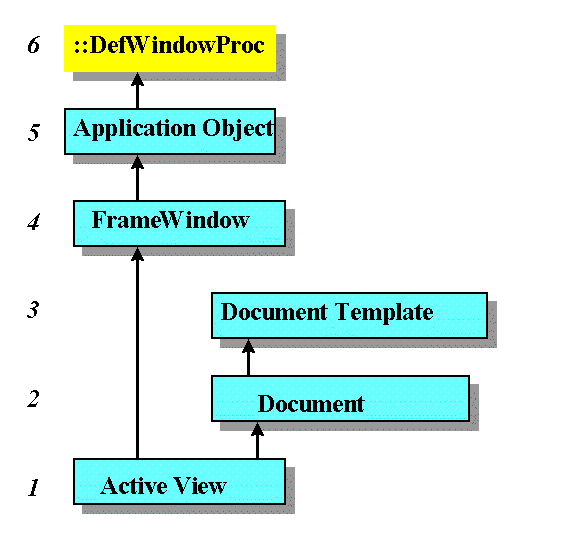C++--MFC的SDI程序的用户命令的处理顺序
- File-New
- File-Open
- File-Exit
- File-Save
- File-Save As
- tool bars
- status
- resize
1.ID_FILE_NEW
入口:ON_COMMAND(ID_FILE_NEW,CWinApp::OnFileNew)
CWinApp::OnFileNew调用CDocManager::OnFileNew.
CDocManager::OnFileNew判断文档模板是否多于一个,是则显示文档类型对话框(AFX_IDD_NEWTYPEDLG) ,让用户选择要创建的文档类型。然后调用CDocTemplate::OpenDocumentFile(NULL).
CDocTemplate::OpenDocumentFile(LPCTSTR lpszPathName,BOOL bMake_Visible=TRUE)对于SDI和MDI的处理不一样。
对于SDI,
(1),若已有文档打开,对其重新初始化,调用CDocument::SaveModified()保存当前文档;若没
有文档存在,则调用CreateNewDocument()创建文档对象,再调用CreateNewFrame(pDoucment,NULL)创建
文档的框架窗口。
(2),若lpszPathName为NULL,则调用CDocument::OnNewDocument()处理新文档,用
pDocument->SetPathName(lpszPathName)设置文档的路径。
(3),判断当前线程主框架窗口是否存在,不存
在则将1中创建的新框架作为主框架。
(4),调用InitialUpdateFrame显示框架窗口。
对于MDI,与SDI基本相同,但是没有第3步。
CDocument::OnNewDocument()首先调用DeleteContents()删除原文档内容,使用m_strPathName.Empty()
清除当前文档路径,SetModifiedFlag(FALSE)。
--------------------------------------------------------------------
摘抄关于ID_FILE_NEW的处理代码
CWinApp::OnFileNew()
{
CDocManager::OnFileNew()
{
if(没有文档模板)
return;
if(有多个文档模板)
{
弹出对话框让用户选择;
取得模板指针;
}
CMultiDocTemplate::OpenDocumentFile()
{
new一个文档;
创建子框架;
构建frame,doc,view之间的关系;
CDocument::OnNewDocument()
{
DeleteContents();
}
InitialUpdateFrame();
return pDoc;
}
}
}
2.ID_FILE_OPEN
入口:ON_COMMAND(ID_FILE_OPEN,CWinApp::OnFileOpen)
CWinApp::OnFileOpen调用CDocManager::OnFileOpen。
CDocManager::OnFileOpen首先显示文件打开对话框(AFX_IDS_OPENFILE),然后调用CWinApp::OpenDocumentFile(FileName)。
CWinApp::OpenDocumentFile(FileName)调用CDocManager::OpenDocumentFile。
CDocManager::OpenDocumentFile(LPCTSTR lpszFileName)遍历文档模板,对每个模板用MatchDocType(szPath,pOpenDocument)匹配文档类型。匹配时主要根据文件扩展名判断。若文件已经在某个文档中打开,则激活文档的第一个视图,否则用匹配的文档模板pBestTemplate->OpenDocumentFile(szPath)。
CDocTemplate::OpenDocumentFile调用CDocument::OnOpenDocument打开文件。
CDocument::OnOpenDocument打开文件,用DeleteContents删除现有文档内容,创建文件对应的CArchive对象loadArchive,Serialize(loadArchive)读文件内容,SetModifiedFlage(FALSE)。
MDI: New Frame, New View?
SDI: Update View?
摘抄关于MDI的ID_FILE_OPEN
CWinApp::OnFileOpen()
{
CDocManager::OnFileOpen()
{
CDocManager::DoPromptFileName()
{
CFileDialog::DoModal();
}
CWinApp::OpenDocumentFile()
{
...选择文档模板;
...调整视图和框架;
CDocTemplate::OpenDocumentFile();
{
判断有无现存文档,是否需要保存
新建框架
判断文件是否存在,调用CMyDoc::OnOpenDocunment/OnNewDocument
}
}
}
}
摘抄关于SDI的ID_FILE_OPEN代码
CWinApp::OnFileOpen()
{
CDocManager::OnFileOpen()
{
CDocManager::DoPromptFileName()
{
CFileDialog::DoModal();
}
CWinApp::OpenDocumentFile()
{
...选择文档模板;
...调整视图和框架;
CDocTemplate::OpenDocumentFile();
{
判断有无现存文档,是否需要保存
新建框架
判断文件是否存在
CMyDoc::OnOpenDocunment()
{
打开文件;
DeleteContents();
建立CArchive;
Serialize;
关闭CArchive;
}
}
}
}
}
3.ID_FILE_SAVE
入口:ON_COMMAND(ID_FILE_SAVE,CDocument::OnFileSave)
CDocument::OnFileSave调用CDocument::DoFileSave()。
CDocument::OnFileSave判断文件是否只读,是则DoSave(NULL),否则DoSave(m_strPathName)。
CDocument::DoSave(LPCTSTR lpszPathName,BOOL bReplace=TRUE)的流程为:
1,判断lpszPathName不空则跳第二步,为空则获取文档的路径名,加上扩展符。bReplace为TRUE则显示保存文件对话框(AFX_IDS_SAVEFILE),否则显示拷贝保存对话框(AFX_IDS+SAVEFILECOPY)。
2,调用CDocument::OnSaveDocument保存文档。
3,若bReplace==TRUE则SetPathName(newName)覆盖当前路径名。
CDocument::OnSaveDocument打开文件,创建CArchive对象saveArchive,Serialize(saveArchive)读写文件,SetModifiedFlag(FALSE)。
摘抄关于ID_FILE_SAVE的代码
CDocument::OnFileSave()
{
DoFileSave(NULL)
{
CFileDialog::DoModal();
OnSaveDocument()
{
CArchive;
Serialize;
}
}
}
4.ID_FILE_SAVEAS
入口:ON_COMMAND(ID_FILE_SAVEAS,CDocument::OnFileSaveAs)
CDocument::OnFileSave调用DoSave(NULL)。
5.ID_FILE_CLOSE
入口:ON_COMMAND(ID_FILE_SAVEAS,CDocument::OnFileClose)
CDocument::OnFileClose调用SaveModified()保存文件,再用OnCloseDocument处理文档关闭。
CDocument::SaveModified()用IsModified()判断是否修改,是则显示文件保存对话框(AFX_IDP_ASK_TO_SAVE),若用户选择“是”,则调用DoFileSave()保存文件。
CDocument::OnCloseDocument()首先销毁文档框架,再用DeleteContents()删除文档内容,若m_bAutoDelete则delete this。
